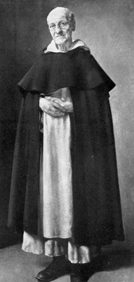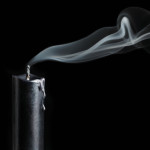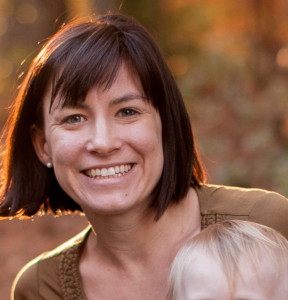The lights suddenly flipped on. The bells started ringing. A young altar boy rushed to light the candles. Black robes began flying into the air and then were caught and flung again, straight up in the highest part of the vaulted ceiling of the church.
The moment had arrived.
It was one of the most beautiful things I’ve ever seen.
Dominican priests typically wear a white robe with a large cowl neck collar and long piece of  fabric down the front. All those things have fancy names, but I will spare you the lesson in monk fashion. For special occasions, like the days of Holy Week, Dominicans add a long black cape that covers over the white robe. It is a solemn gesture, a gesture of reverence for the solemn events that are being remembered. To my eyes, it is a shroud of darkness, of mystery. The cape always draws my attention, and something in me wishes I could wear a cape without being thought of as a Lord of the Rings fangirl gone wild.
fabric down the front. All those things have fancy names, but I will spare you the lesson in monk fashion. For special occasions, like the days of Holy Week, Dominicans add a long black cape that covers over the white robe. It is a solemn gesture, a gesture of reverence for the solemn events that are being remembered. To my eyes, it is a shroud of darkness, of mystery. The cape always draws my attention, and something in me wishes I could wear a cape without being thought of as a Lord of the Rings fangirl gone wild.
Watching the black capes thrown into the air, I was standing tiptoe in the courtyard of the church, peering over the heads of hundreds of standing figures. I was in Poland as a solo personal pilgrimage to honor a saint that I hold dear and was spending the week prior to Easter making day trips and exploring Krakow.
I’ve always loved the Easter vigil, the very long liturgy of Saturday night that begins in darkness and ends in Easter joy. I didn’t understand the Polish but I understood that moment. The church was suddenly bathed in light; darkness was literally cast aside. My melancholic spirit knew: He is RISEN!
This year, I was again in the presence of the white-robed Dominicans for the days leading up to Easter. My friend had taken several courses at the Dominicans House of Studies and wished to attend the liturgies amongst the preachers and teachers whom she loved and respected. I was up for anything and not-so-secretly hoped that cape throwing was a part of the American tradition. (It wasn’t. Only cape removal and tactful folding.) Nonetheless, I encountered another tradition.
We attended Tene brae, a candlelit chanting of the Psalms that led into the Holy Week liturgies. A chapel full of robed religious singing Scripture in the ancient prayer of the Church put me into a reflective, quiet place. Stillness came; silence set in. As the chanting ending, all of the light was extinguished.
brae, a candlelit chanting of the Psalms that led into the Holy Week liturgies. A chapel full of robed religious singing Scripture in the ancient prayer of the Church put me into a reflective, quiet place. Stillness came; silence set in. As the chanting ending, all of the light was extinguished.
The entire church stood in pitch blackness and perfect silence.
Time passed.
My mind raced, “How long are we going to silently stand here? How are all these people going to get out of here safely?”
More time passed. My mental soundtrack didn’t let up, “I wish I could read my program so I understood what was going on.”
And then, a moment. A moment of standing in darkness with 200 other people. A moment of being in silent worship together; a moment of turning my attention toward Him.
Breaking into that moment, a wretched clanging of drums and cacophonous noises filled the darkened chapel. On and on it continued, a noise that disturbed the peace of the space and the peace of the spirit.
Just as quickly as it began, the noise ended. The lights returned and the service ended. I glanced down at my program, “All creation shudders at the death of the Lord.”
In the first, I was alone and rejoiced to see the darkness cast aside.
In the second, I stood together in darkness and worshipped and trusted the chaos had meaning.
To both I answer, “Amen.“

